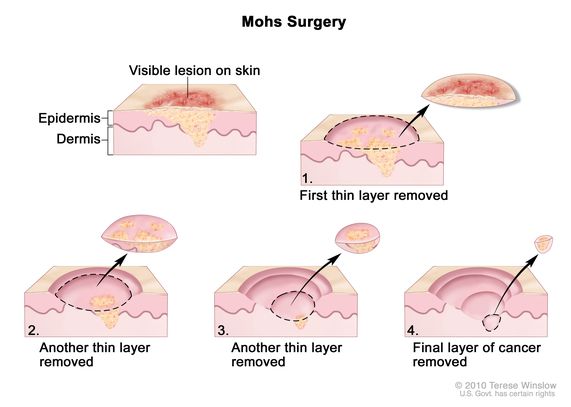Posted March 29, 2024 in Uncategorized

What exactly is Mohs surgery?
Mohs surgery is a modern way to treat skin cancer. The surgeon removes thin layers of skin, checking each one under a microscope to make sure all the cancer is gone. They repeat this until only healthy tissue is left.
Over time, Mohs surgery has evolved into the most precise and advanced treatment option for skin cancer, boasting success rates as high as 99%. Its unparalleled efficacy stems from its thorough evaluation of the tissue surrounding the cancer, surpassing the capabilities of traditional skin cancer surgery techniques.
Consequently, Mohs surgery has established itself as the benchmark treatment for high-risk skin cancers, particularly those situated on sensitive areas like the head and neck or those exhibiting aggressive growth patterns.
Why is Mohs Surgery Performed?
Mohs surgery serves as a valuable option for addressing various types of skin cancer, including basal cell carcinoma and squamous cell carcinoma.
Your healthcare provider might recommend this approach for skin cancers that meet the following criteria:
- Significant size
- Display aggressive pathology (i.e., the cells show an infiltrative growth pattern)
- Characterized by infiltrative growth patterns in cells Positioned in sensitive areas where preserving healthy tissue is crucial: such as the head and neck, digits, or genital regions.
- Present in individuals with compromised immune systems due to factors like organ transplants, Lymphoma, or other conditions
- Experiencing recurrence following prior treatment.
Mohs Procedure: What to Expect
The Mohs procedure is conducted in an outpatient setting, with the surgeon using local anesthesia to numb the area completely. Following the administration of the anesthetic, the surgeon employs a scalpel to meticulously remove thin, saucer-shaped layers of skin in a sequential manner.
Mapping plays a crucial role in the process, aiding the surgeon in planning the removal of each layer. The surgeon utilizes colored dyes to mark areas of the excised skin samples and creates a map of the surgical area, either through freehand drawing or with the assistance of a computer application. This map serves as a guide for the surgical procedure and assists in pinpointing areas where cancerous cells persist.
Some cancers may infiltrate deeply into lower layers of the skin, appearing small on the surface but exhibiting extensive growth several layers below. Conversely, other cancers may be superficial, necessitating the removal of only a few minor layers.
Upon removal, each tissue layer is promptly frozen, thinly sliced, and processed onto glass slides by a specialized Mohs histotechnician. This preparation typically takes about an hour.
Afterward, the Mohs surgeon examines the slides under a microscope to assess the skin cancer’s extent and find any tiny roots. If cancer cells are found at the edges, the map helps guide the removal of more tissue layers precisely from those areas. This cycle repeats until all cancer is gone, protecting as much healthy tissue as possible around it.
While some Mohs procedures may not necessitate reconstructive surgery, for those that do, the reconstruction typically occurs promptly after the removal of the skin cancer by your Mohs surgeon.
Postoperative Care Following Mohs Surgery:
Following the procedure, the surgeon will dress the wound and offer instructions for care. This may involve using topical ointments, medications, or specific care guidelines to minimize the chances of infection.
Reconstruction after Mohs Surgery:
In instances where Mohs surgery results in a sizable defect in a prominent or sensitive area such as the nose, eyes, or ears, options like skin grafts (transferring a patch of skin from another body area) or local flaps (repositioning a section of nearby skin) may be employed to cover the defect and restore facial function and appearance.
For more complex cases requiring extensive reconstruction, procedures are conducted in the operating room under sedation or general anesthesia.
During such scenarios, your Mohs surgeon might collaborate with specialists such as plastic, facial plastic, or oculoplastic surgeons to execute the reconstructive process seamlessly. A discussion with your Mohs surgeon will aid in determining the appropriate type of reconstructive surgery needed for your specific situation.